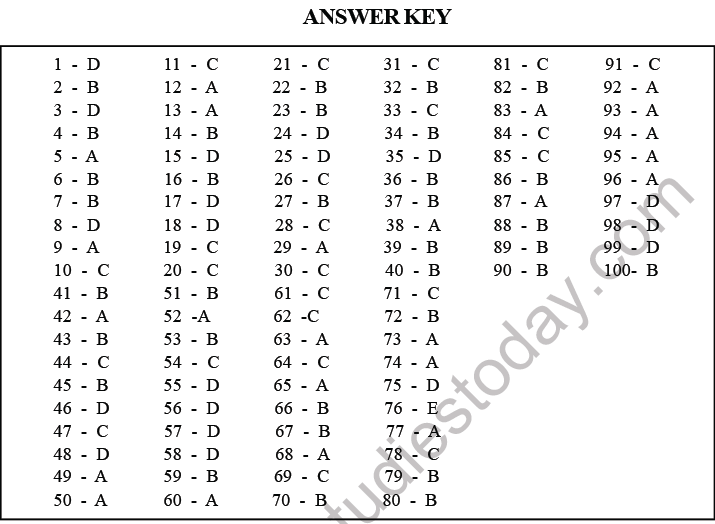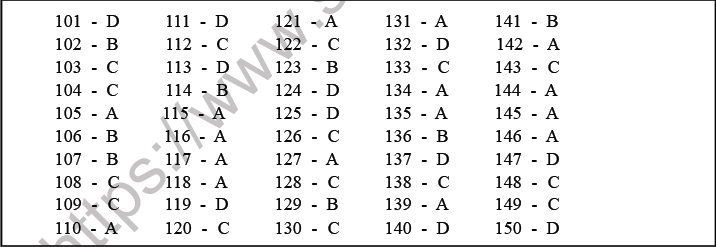IMPORTANT POINTS
• GENETICS:- It is a branch of biology that deals with the study of heredity and variation.
• Gregor Johann Mendel :- (1822-1884) is called the Father of Genetics.
• The term genetics was first used by Willam Bateson..
• Johansen (1909) coined the term "genes" for Mendel"s "factors.
• Punnett square is a checker board which was derived by R. C. Punnett.
MENDELISM:-
Mendel’s laws of heredity were described in his paper "Experiments on plant
Hybridization" which was published is the forth volume of Annual proceeding of naturalHistory Society of Brunn in 1865.
BACK CROSS:-
A cross of F1 hybrid with either of the two parents is known as back cross.
• When F1 off springs are crossed with the dominant parents all the F2 off springs develop dominant character.
• On the other hand when F1 hybrids are crossed with recessive parent, individuals with both the phenotypes appear in equal proportions. While both the crosses are known as backcross, the second one is specified as test cross.
GENE INTERACTION :-
Gene interaction is the modification of normal phenotypic expression of a gene due to either its alleles or non- allelic genes.
Gene interaction is of two types:-
(i) Intragenic interaction
(ii) Intergenic interaction
Intragenic interaction :-
In intragenic interaction , two alleles of a gene which are present on the same gene locus on the two homologous chromosomes ,react to produce modified phenotype.
Eq :- 1. Incomplete dominance
2. Codominance
3. Multiple alleles
Intergenic interaction :-
It is the modified effect of a gene under the influence of a non - allelic gene.
Eq :- 1. Complementary genes
2. Supplementary genes
Complementary genes :-
If two genes present on different loci produce the same effect when present alone but interact to form a new trait when present together are called complementary genes.
Complementary gene ratio is 9 : 7
Supplementary Genes :-
Supplementary genes are two non allelic genes in which one type of gene produces its effect whether the other is present or not and the second gene produces its effect only in the
presence of the first, usually forming new trait.
Supplementary gene ratio is 9 : 3 : 4
INHERITANCE :-
There are two types of inheritance
1. Qualitative inheritance / Monogenic inheritance
2. Quantitative inheritance / polygenic inheritance
Monogenic inhenitance :-
→ A single dominant gene inflences a complete trait.
→ Intermediate forms are not produced
Polygenic inheritance :-
→ Full trait is shown when all dominant alleles present.
→ Each dominant allele expresses a part or unit of the trait.
→ Intermediate forms are produced
Ex:- Human skin colour
VARIATIONS :-
→ Variations are differences found in morphological, physiological, Cytological and behavioural traits of individuals belonging to same species.
→ Hereditary variations are transmitted from generation to generation where as environmental variations are temporary and do not relate with last or next generation.
Types of Variations :-
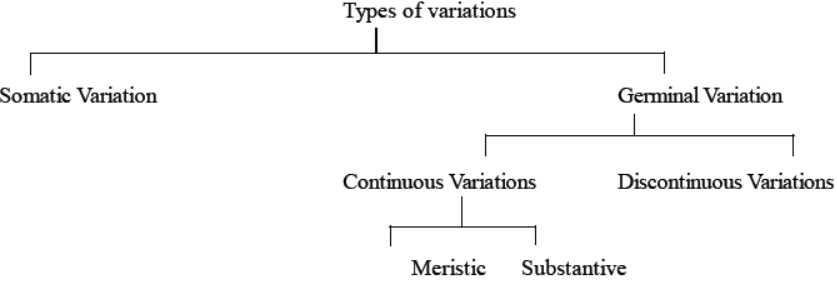
Somatic Variations :-
Somatic Variations affect the somatic or body cells of the organisms and these die with the death of the individual and thus are non - inheritable.
Somatic variations are also called modifications of acquired variations because they are acquired by an individual during its life time.
They are formed due to three reasons
→1. Environmental factors
→2. Use and disuse of organs
→3. Conscious efforts
GERMINAL VARIATIONS :-
Germinal variations are inheritable variations formed mostly in germinal cells which are either already present in the ancestor or develop as new due to mutations.
Gerninal variations are of two thypes :-
1. Continuous variations
2. Discontinuous variation
Continuous variations :-
Continuous variations are also called recombinations. They are of two types:-
1. Meristic 2. Substantive.
Meristic :-
Meristic Variation influencing number of parts like number of grains in an ear of wheat.
Substantive :-
Substantive variation influencing appearance like height , colour, yield of milk, etc.,
Discontinuous Variations :-
Discontinuous Variations are mutations which are sudden , unpredictable inheritable varitions not connected with the average by intermediate stages. Discontinuous are caused by chromosomal abberrations change in chromosome number and gene mutations.
A.Garrod- Father of human genetics & biochemical genetics.
- Garrod discovered first human metabolic genetic disorder which is called alkapto nuria (black urine disease.)
- He gave the concept "One mutant gene one metabolic block."
• Poly genic inheritance first described by Nilsson- Ehle in kernel colour of wheat.
• The inheritance of colour of skin in human studied by Davenport.
• Bleeder’s disease (haemophilia ) was discovered by john Otto (1803).
• Colourblindness was discovered by Horner.
• Colurblindness is also called Daltonism.
Devices used in Human Genetical Studies:-
The study and analysis of human genetics is performed by many methods like pedigree analysis , statistical analysis and human karyotyping.
Pedigree Analysis :-
• Study of ancestral history of Man of transmission of genetic characters from one generation to next, is pedigree analysis.
• Dwarfism, albinism, Colour blindness haemophilia, etc., are genetically transmitted characters.
• To study and analysis them a pedigree of genetic facts and following symbols are used.
Symbols Used in pedigree :-
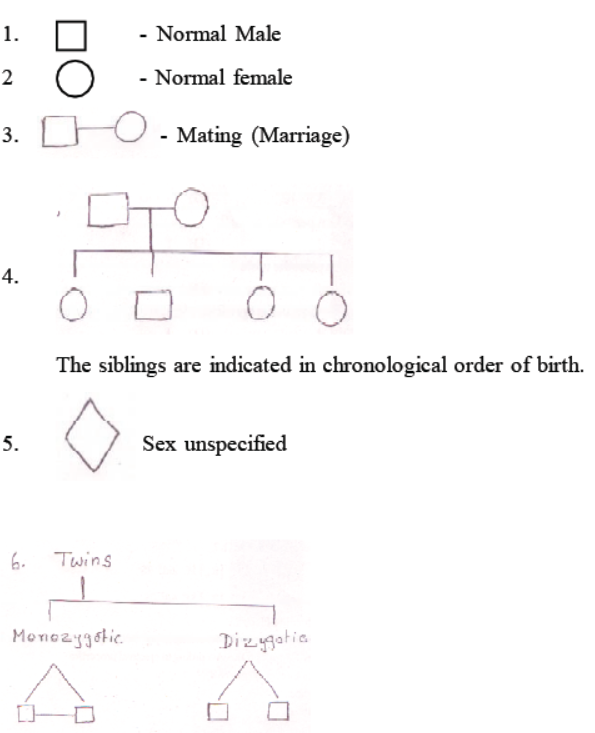
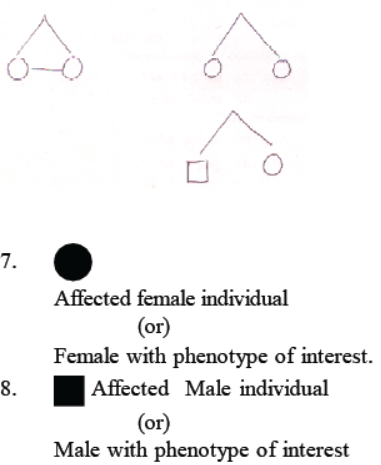
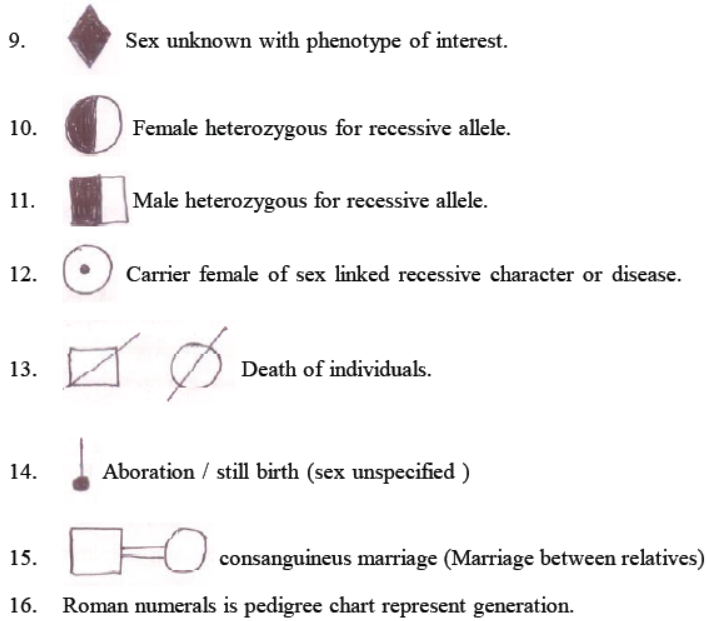
(1) Genotype is
(A) Genetic composition of many organisms.
(B) Genetic composition of plastids.
(C) Genetic composition of germ cells.
(D) Genetic composition of an individual.
(2) Mendelism is genetics of
(A) Haploids (B) Diploids (C) Prokaryotes (D) All the above
(3) Which technique is used by Mendel for hybridization ?
(A) Emasculation (B) Bagging (C) Protoplast fusion (D) Both A & B
(4) Phenotypic ratio 3:1 proves
(A) Dominance (B) Segregation
(C) Crossing over (D) Independent Assortment
(5) What is the ratio of homozygous plants for both dominant characters in F2 of a Dilybrid cross ?
(A) 1/16 (B) 3/16 (C) 4/16 (D) 9/16
(6) Which of the following is significance of dominance ?
(A) Organisms with dominant genes are more vital
(B) Harmful mutations are not expressed due to dominant gene
(C) Heterosis is due to dominant gene
(D) All the above
(7) From a single ear of corn, a farmer planted 200 kernels which produced 140 tall & 40 short plants. The genotypes of these off springs are most likely.
(A) TT ,tt (B) TT , Tt , tt (C) TT ,Tt (D) Tt ,tt
(8) A useful process for determining whether an individual is homozygous or heterozygous is
(A) cross - breeding (b) self fertilization
(C) Back - crossing (d) Test cross
(9) Heterozygous tall plants were crossed with dwarf plants what will be the ratio of dwarf plants in the following progency ?
(A) 50%(B) 25 % (C) 75% (D) 100%
(10) Genetic recombinations occur through
(A) Mitosis & fertilization
(B) Mitosis & Meiosis
(C) Meiosis & fertilization
(D) None
(11) Which of the following is the unit of inheritance ?
(A) Phenotype (B) Genotype (C) Gene (D) Genome
(12) Allele is the
(A) Alternate trait of gene pair
(B) Total number of genes for a trait
(C) Total number of chromosomes
(D) Total number of chromosomes of a haploid set.
(13) Types of phenotypes of F2 generation of dihybrid cross ?
(A) 4 (B) 16 (C) 8 (D) 9
(14) Cross XXYy ×xxYy yields Xx YY:XxYy :Xxyy:xxyy offspring in the ratio of
(A) 0 : 3 : 1 : 1 (B) 1 : 2 : 1 : 0
(C) 1 : 1 : 1 : 1 (D) 1 : 2 : 1 : 1
(15) Genes do not occur in pairs in
(A) Zygote (B) Somatic cell
(C) Endosperm cell (D) Gametes
(16) Genotype - Phenotype concept was first produced by
(A) Bateson (B) Johannsen (C) Sutton&Boveri (D) Punnet
(17) 1: 1: 1: 1 ratio shows
(A) Monohybrid cross
(B) Dihybrid cross
(C) Back cross
(D) Dihybrid test cross
18) Test cross is
(A) Tt × Tt (B) Tt × TT (C) TT × TT (D) Tt × tt
(19) In a plant, gene "T" is responsible for tallness and its recessive allele "t" for dwarfness and "R" is reponsible for red colour flower and its recessive allele "r" of white flower colour. A tall and red flowered plant with genotype TtRr crossed with dwarf and red flowered ttRr.
What is the percentage of dwarf - white flowered offspring of above cross ?
(A) 50% (B) 6.25% (C) 12.5 % (D) 50 %
(20) In Mirabilis plant the appearance of the pink hybrid (Rr) between cross of a red (RR) and white (rr) flower parent indicates
(A) Segregation (B) Dominance (C) Incomplete dominance (D) Heterosis
(21) If there were only parental combinations in F2 of a dihybrid cross then Mendel might have discovered ?
(A) Independent assortment (B) Atavism
(C) Linkage (D) Repulsion
(22) Medelian dihybrid and dihybrid with linkage are respectively related with how many chromosomes?
(A) 1 pair & 2 pair (b) 2 pair & 1 pair
(C) 2 pair & 2 pair (d) 1 pair & 1 pair
In dihybrid with linkage , 2 pairs of genes located in similar homobgous chromosomes
(23) If distance between gene on chromosome in more , then gene shows :-
(A) Less Linkag (B) strong linkage
(C) weak linkage (D) incomplete linkage
(24) Which of the following conditions represent a case of co- dominant genes ?
(A) A gene expresses itself , suppressing the phenotypic effect of its alleles.
(B) enes that are similar in phenotypic effect when present separately, but when together interact to produce a different trait.
(C) Alleles, both of which interact to produce effect in homozygous condition
(D) Alleles, both of which interact to produce an independent effect in heterozygous condition.
(25) A gene located an y - chromosome and therefore, transmitted from father to son is known as
(A) Supplementary gene (B) Complementary gene
(C) Duplicate gene (D) Holandric gene
(26) In multiple allele system a gamete possesses
(A) 2 alleles (B) 3 alleles
(C) one allele (D) several alleles
(27) Blood grouping in humans is controlled by
(A) 4 alleles in which IA is dominant
(B) 3 alleles in which IA and IB are dominant
(C) 2 alleles in which none is dominant
(D) 3 alleles in which IA is recessive
(28) Muliple alleles are present
(A) in different chromosomes
(B) at different loci on chromosomes
(C) at the same locus on homologous chromosome
(D) at the non homologous chromosome
(29) what is called pleiotropism ?
(A) Phenomenon of multiple effect of a simple gene
(B) Phenomenon of multiple effect of multiple genes
(C) Phenomenon of multiple effect of multiple alleles
(D) all of the above
(30) In a family, father has a blood group 'A' and mother has a blood group 'B', Children show 50 % probability for a blood group "AB" indicate that -
(A) Father is heterozygous
(B) Mother is heterozygous
(C) Either of parent is heterozygous
(D) Mother is homozygous
(31) The longer the chromosome of an organism, the more genetic variability it gets from,
(A) Independent assortment (B) Linkage
(C) Crossing over (D) Mutation.
(32) Which statement is incorrect about linkage ?
(A) It helps in maintaining the valuable traits of new varieties.
(B) It helps in forming new recombinants.
(C) Knowledge of linkage helps the breeder to combine all desirable traits in a single variety.
(D) It helps in locating genes on chromosome.
(33) Genetic balance theory for sex determination in Drosophila was proposed by
(A) Prof. R. P. Roy (B) H. E. Warmbe
(C) C.B. Bridges (D) Mc. Chang
(34) In Bonellia all larva are genetically and cytologically similar. In this worm mole individuals live inthe uterus of female. If a particular larva settle near proboscis of an adult female, it becomes a male individuals. Larva develops free in water it becomes.
(A) Male individuals (B) Female individuals
(C) Inter Sex (D) Super female
(35) F2 generation is produced as a result of
(A) Crossing F1 individuals with dominant parent
(B) Crossing F1 individuals with recessive parent
(C) Crossing one of the parental individual with dominant individual.
(D) Crossing F1 individuals amongst them selves.
(36) Segregation of genes take place during which phase of cell division ?
(A) Metaphase (B) Anaphase (C) prophase (D) Embryo formation
(37) A couple has four daughters. The percentage probability of fifth child to be a Daughter is.
(A) 10 (B) 50 (C) 75 (D) 100
(38) In human being sex chromosomal complement is
(A) XX - XY (B) XX - XO (C) ZO - ZZ (D) ZW - ZZ
(39) Zea mays has 10 pairs of chromosomes . Linkage groups present in it are
(A) 5 (B) 10 (C) 20 (D) 40
(40) Crossing over during meiosis occurs between
(A) sister chromatids (B) Non sister chromatids
(C) Centromeres (D) Non homologous chromosomes
(41) Incomplete linkage in Drosophila produces off springs with parental and non-parental combinations.State the percentage of non parental combination of Drosophila.
(A) 83% (B) 17 % (C) 15 % (D) 85 %
(42) What does the term recombination describe ?
(A) Generation of non- parental gene combination
(B) Generation of parental gene combination
(C) Generation of internal gene combination
(D) All of the above
(43) A cross between hybrid and a parent is known as
(A) Test cross (B) Back cross
(C) Monohybrid cross (D) Reciprocal cross
(44) Checkerboard method of calculations was developed by
(A) Mendel (B) Bateson (C) punnett (D) Morgan
(45) Punnet square is used to know
(A) outcome of a cross (B) probable result of a cross
(C) Types of gametes (D) Number of gametes
(46.) First generation after a cross is
(A) First filial generation (B) F1 gneratioon
(C) Second filial generation (D) Both (A) and (B)
(47.) In humans , height shows a lot of variation . It is an example of
(A) Multiple alleles (B) Pleiotropic inheritance
(C) polygenic inheritance (D) False allelic inheritance
(48) Meiosis produce 4 daughter cells but each daughter cell differ from one another because of
(A) Crossing over (B) Independent assortment
(C) Change in chromosome number (D) Both A & B
(49) In T. H. Morgan"s Experiment on Drosophilia what will be the result when F1 female flies are crossed with double recessive male files ?
(A) 83% parental combinations
17% Recombinations
(B) 41.5 % parental combinations
58.5% recombinations
(C) 60% parental combinations
40 % recombinations
( D) 90 % parental combinations
10% Recombinations
(50) which cross yielded a ratio of 7:1 :1:7 ?
(A) Test cross (Dihybrid) - Bateson and punnet
(B) Test cross (Monohybrid) - Bateson and punnet
(C) Test cross (Dihybrid) - Carrel correns
(D) Test cross ( Dihybrid) - Mendel & Morgan
(51) When there is no Possibility of independent assortment of genes during gametogenesis then What Will be the real ratio of F2 in dihybrd cross?
(A) 9 : 3 : 3 : 1 (B) 11 : 1 : 1 : 3
(C) 12 : 1 : 1 : 2 (D) 9 : 3 : 2 : 2
(52 ) What was the expected ratio of F2 by Bateson and Punnet in their dihybridization experiment done on Lathyruas odoratus?
(A) 9 : 3 : 3 : 1 (B) 11 : 1 : 1 : 3
(C) 12 : 1 : 1 : 3 (D) 9 : 3 : 2 : 2
(53) What is incorrect statement Gynandromorphs ?
(A) Individuals who show male characters and female characters
(B) Individuals who show only female characters
(C) It happens due to less of X- chromosomes
(D) It happens due to binacleated eggs
(54) What is Barr body ?
(A) One more than the number of X - chromosomes
(B) One more than the number of Y-chromosomes
(C) One less than the number of X - chromosomes
(D) Two less than the number of X - chromosomes
(55) What is called Free martin ?
(A) Sterile male born along with a fertile female
(B) Sterile intersex born along with a fertile female
(C) Sterile super male born along with a intersex
(D) Sterile female born along with a fertile male
(56) Out of the following , Find out the reason for occurrence of free martin in cattles ?
(A) Both the twins are connected by a common umbilical cord
(B) Gonad of the male develop earlier then those of the female
(C) Male hormones reach the female embryo and influence the development of male sex in the female embryo
(D) All of the above
(57) In this group of plants male is heterogametic and female is homogametic type
(A) Gymnosperms (B) Bryophytes (C) pteridophytes (D) angiosperms
(58) Name the Plant possessing two X chromosomes
(A) Humulus japanic (B) Dioscoria sinulate
(C) Flagellaria (D) Both (A) & (B)
(59) State the mutant gene Which converts the male flowers into female flowers In Maize plant
(A) TA TA (B) ta ta (C) TA Ta (D) Both (A) &(C)
(60) By which gene sex is determind in Spinach ?
(A) Single gene "m" located in the X- chromosome
(B) Single gene "m" located in the Y- chromosome
(C) Single gene "t" located in the X- chromosome
(D) Single gene "t" located in the Y- chromosome
(61) Which factor in nature causes discontinuous Variation in a population ?
(A) Recombination (B) Shufflng of parental genes
(C) Mutation (D) Geneflow
(62) This is reversal of mutation
(A) Spontneous mutation (B) Zygotic mutation
(C) Back mutation (D) Recessive mutation
(63) Which condition among the following is lethal ?
(A) (2n-2) (B) (2n +2) (C) (2n +1) (D) (2n- 1)
(64) State the cause of Philadelphia syndrome
(A) Deletion from the long arm of chromosome number 20
(B) Duplication in long arm of chromosome number 20
(C) Deletion from the long arm of chromosome number 22
(D) Deletion from the short arm of chromosome number 22
(65) which statement is incorrect regarding gene mutation
(A) Mutations may be gradual or they may not be induced.
(B) Mutation is an evolutionary agent
(C) Any gene can undergo mutation
(D) Mutated gene is harmful to the individual
(66) What happens to excessive phenylalanine accumulation in the blood of phenylketonuria patient ?
(A) Get deposited on synovial membrane
(B) excreted in urine
(C) Get deposited in storage organs
(D) All of the above
(67) Name the enzyme needed for the following biochemical reaction

(A) Melanase (B) tyrosinase (C) Tyrosine aminase (D) transaminase
(68) Which is very common method to study Human Karyotype ?
(A) Blood culture method
(B) Tissue culture method
(C) Pedigree method
(D) Statistical method
(69) "Large thick and Swollen tongue and droping lips"----- are the symptoms of which genetical disorder
(A) Autosomal aneuploidy
(B) Trisomy of 21st chromosome
(C) Down’s syndrome
(D) Total number of chromosomes become 47
(70) Name the disorder caused by trisomy of sex chromosomes.
(A) Down’s syndrome (B) Kline felter’s syndrome
(C) Turner’s syndrome (D) Edward’s syndrome
(71) Match the following :-
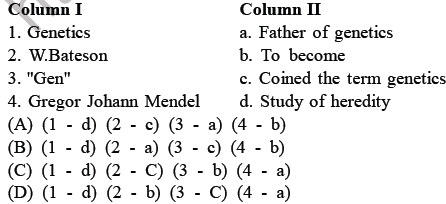
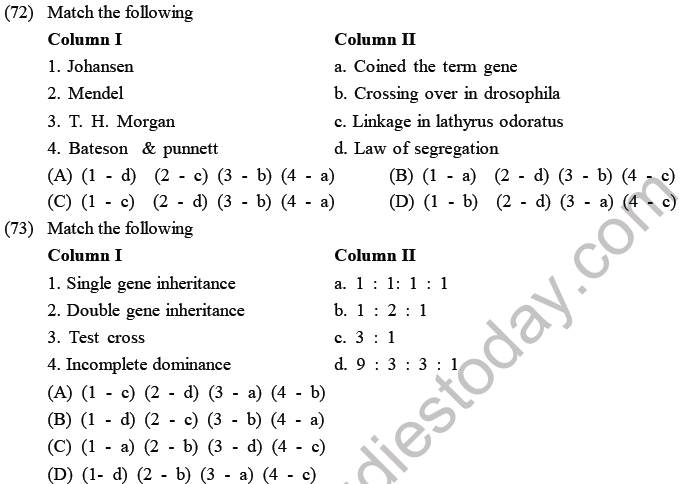
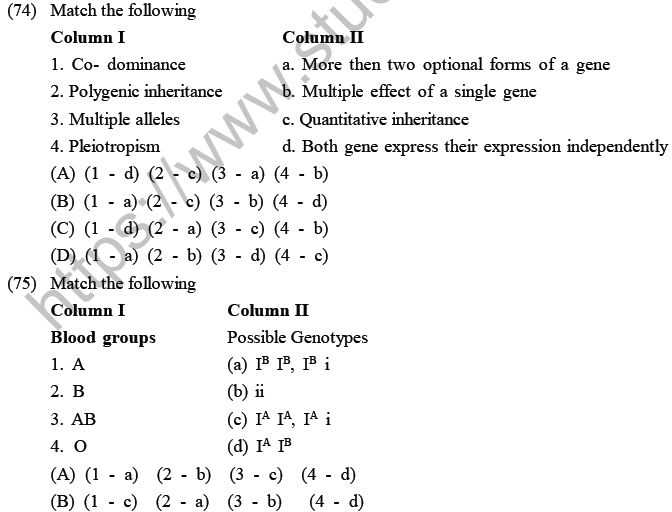
(C) (1 - c) (2 - b) (3 - d) (4 - a)
(D) (1 - c) (2 - a) (3 - d) (4 - b)
(76) The cross between heterozygous A blood group mother with B blood group father heterozygous).What will be the expected blood group of First filial generation.
(A) AB group (B)A group (C) B group (D) O group
(E) All of the above
(77) What will be expected blood groups in the off spring when there is a cross between AB blood group mother and heterozygous B blood group father ?
(a) 25 % AB group
25 % A group
50 % B group
(b) 50 % AB group
25 % A group
25 % B group
(c) 25% AB group
50% O group
25 % A group
(d) 25 % O group
50 % B group
25 % A group
(78) Which law of Mendel can be explained on chromosomal basis of inheritance ?
(A) Law of dominance
(B) Law of segregation
(C) Law of independent assortment
(D) All the above
(79) What does the chart & given below represent ?
Name the abnormality seen in chromosome number - 2
(A) Interstitial Deletion
(B) Terminal Deletion
(C) Tandem Duplication
(D) Reverse Duplicaton
What do A, B, C represent in the given diagram?
(A) Centromere, chromatids chiasma (B) Chromatid, chiasma, centromere
(C) Centromere, chiasma, chromatid (D) Chromatid, chiasma centromere
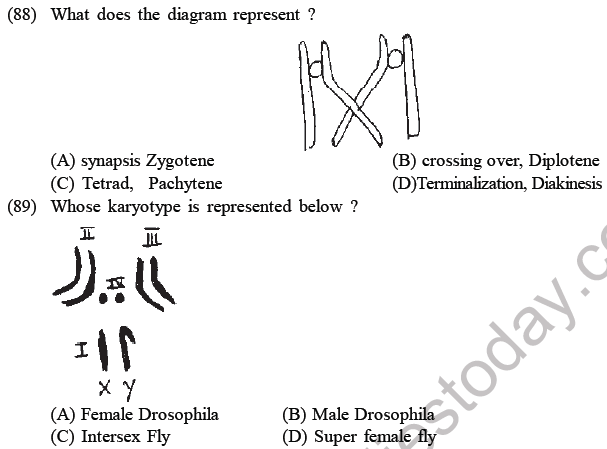
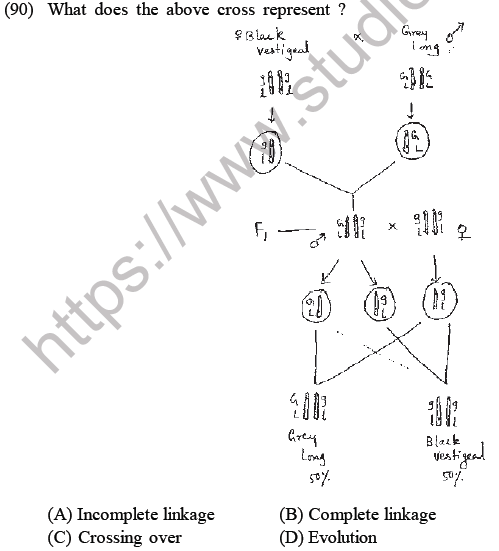
Assertion & Reason Type Questions
The Questions consist of two statements each - Assertion (A) and Reason (R).
To answer these questions choose any one of the following four responses.
(A) If both (A) and (R) are true and (R) is the correct explanation of (A)
(B) If both (A) and (R) are true but (R) is not the correct explanation of (A)
(C) If (A) is true but (R) is false
(D) If both (A) and (R) are false.
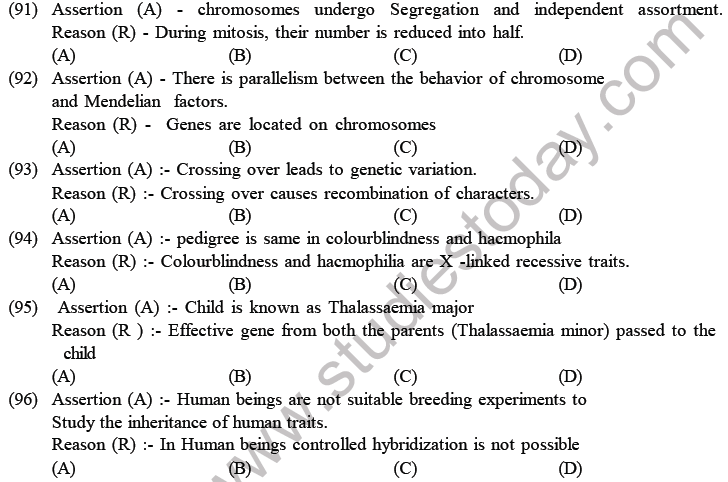
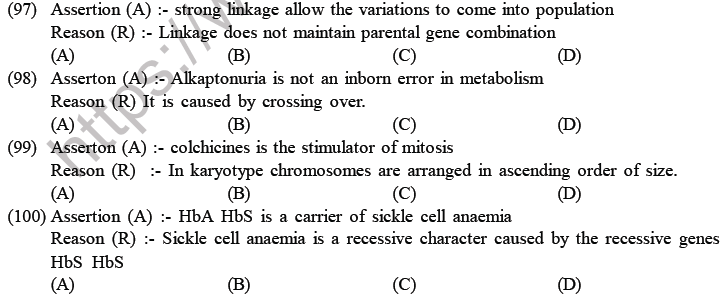
Questions From Competitive Exams
(101) The genes Controlling the seven characters of a pea plant studied by Mendel are now known to be located on how many different chromosomes?
(A) Seven (B) Six (C) Five (D) Four
(102) Which one of the following traits of garden pea studied by Mendel was a recessive feature?
(A) Axial flower position (B) Green Seed colour
(C) Green pod colour (D) Round Seed shape
(103) Down's Syndrome is caused by an extra copy of chromosome number 21. What percent age of off spring produced by an affected mother and a normal father?
(A) 100% (B) 75% (C) 50% (D) 25%
(104) Lack of independent assortment of two genes A and B in fruitfly the Drosophilia is due to
(A) Repulsion (B) Recombination (C) Linkage (D) Crossing over
(105). A male human is heterozygous for autosomal genes A and B and is also hemizygous for haemophilic gene h. What proportion of his sperms will be abh?
(A) 1/8 (B) 1/32 (C) 1/16 (D) 1/4
(106). In a plant, red fruit (R) is dominant over yellow fruit (r) and tallness (T) is dominant over shortness (t).
If a plant with RRTt genotype is crossed with a plant that is rrtt.
(A) 25% will be tall with red fruit
(B) 50% will be tall with red fruit
(C) 75% will be tall with red fruit
(D) All the offspring will be tall with red fruit.
(107) A normal woman, whose father was colour blind is married with normal man. The sons would be
(A) 75% Colour blind (B) 50% colour blind
(C) all normal (D) all colourblind
(108).The recessive genes located on X - chromosome of humans are always
(A) Lethal (B) Sub - Lethal
(C) expressed in males (D) expressed in females
(109). Inorder to find out the different types of gametes produced by a pea plant having the genotype AaBb it should be crossed to a plant with the genotype
(A) AABB (B) AaBb (C) aabb (D) aaBB
(110). A woman with normal vision, but whose father was colourblind, marries a colourblind man. Suppose that the fourth child of this couple was a boy. This boy
(A) May be colourblind or may be of normal vision
(B) Must be colourblind
(C) Must have normal colour vision
(D) Will be partially colourblind since he is heterozygous for the colourblind mutant allele.
(111). Which of the following is not a hereditary disease?
(A) Cystic Fibrosis (B) Thalassaemia (C) Haemophilia (D) Cretinism
(112). Haemophilia is more commonly seen in human males than in human females because
(A) a greater proportion of girls die in infancy
(B) this disease is due to a Y- linked recessive mutation
(C) this disease is due to an X - linked recessive mutation
(d) this disease is due to an X- linked dominant mutation
(113). A woman with 47 chromosomes due to 3 copies of chromosome 21 is characterized by
(A) Super Femaleness (B) Triploidy
(C) Turner's Syndrome (D) Down's Syndrome
(114). A man and a woman, who do not show any apparent signs of a certain inherited disease, have Seven Children (2 daughters and 5 sons). Three of the Sons suffer from the given disease but none of the daughters affected. Which of the following mode
of inheritance do you suggest for this disease?
(A) Sex - linked dominant
(B) Sex - linked recessive
(C) Sex - limited recessive
(D) Autosomal dominant
(115).Which one of the following is an example of polygenic inheritance ?
(A) Skin colour in humans
(B) Flower colour in Miralibilis jalapa
(C) Production of male honey bee
(D) Pod shape in garden pea
(116). Phenotype of an organism is the result of
(A) genotype and environmental interactions
(B) mutations and linkages
(C) Cytoplasmic effects and nutrition
(D) environmental changes and sexual dimorphism
(117). How many different gametes will be produced by a plant having the genotype AABbCC?
(A) Two (B) Three (C) Four (D) Nine
(118). In Mendel's experiments with garden pea, round seed shape (RR) was dominant over wrinkledSeeds (rr), Yellow cotyledon (YY) was dominant over green cotyledon (yy). What are the expected Phenotypes in the F2 generation of the cross RRYY x rryy?
(A) Round Seeds with yellow cotyledons, and wrinkled seeds with yellow cotyle dons
(B) Only round seeds with green cotyledons
(C) Only wrinkled seeds with yellow cotyledons
(D) Only wrinkled seeds with green cotyledons
(119) Test cross involves
(A) Crossing between two genotypes with dominant trait
(B) Crossing between two genotypes with recessive trait
(C) Crossing between two F1 hybrids
(D) Crossing the F1 hybrid with a double recessive genotype
(120). Cri - du -chat Syndrome in humans is caused by the
(A) trisomy of 21st chromosome
(B) Fertilization of an XX egg by a normal Y - bearing sperm
(C) loss of half of the short arm of chromosome 5
(D) loss of half of the long arm of chromosome 5
(121). If a colourblind woman marries a normal visioned man, their sons will be
(A) all colourblind
(B) all normal visioned
(C) one - half colourblind and one - half normal
(D) three - fourths colourblind and one - fourth normal
(122). In the hexaploid wheat, the haploid (n) and basic (X) numbers of chromosomes are
(A) n = 21 and X = 21
(B) n = 21 and X =14
(C) n = 21 and X = 7
(D) n = 7 and X =21
(123). Inheritance of skin colour in humans is an example of
(A) Point Mutation
(B) Polygenic inheritance
(C) Codominance
(D) Chromosomal aberrations
(124). In pea plants, yellow seeds are dominant to green, If a heterozygous yellow seeded plant isCorssed with a green seeded plants, what ratio of yellow and green seeded plants, would you expect in F1 generation?
(A) 9 : 1 (B) 1 : 3 (C) 3 : 1 (D) 50 : 50
(125). A human male produces sperms with the genotypes AB , Ab , aB , ab pertaining to two diallelic characters in equal proportions. What is the corresponding genotype of this person?
(A) AaBB (B) AABb (C) AABB (D) AaBb
(126).Which one of the following conditions in human is correctly matched with its chromosomal abnormality / linkage ?
(A) Erythro blastosis foetalis - X - linked
(B) Down's syndrome - 44 autosomes +XXY
(C) Kline Felter's syndrome - 44 autosomes +XXY
(D) Colour blindness - Y - linked.
(127). Study the pedigree chart given below what does it show?
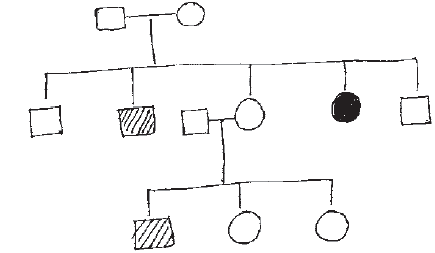
(A) Inheritance of a Condition like phenyl ketonuria as an autosomal recessivetrait
(B) The pedigree chart is wrong as this is not possible
(C) Inheritance of recessive sex - linked disease like haemophilia
(128). The most popularly known blood grouping is the ABO grouping. It is named ABO and not ABC, because "O" in it refers to having
(A) Overdominance of this type on the genes for A and B types
(B) One antibody only - either anti - A or anti - B on the RBCs
(C) no antigens A and B on RBCs
(D) other antigens besides A and B on RBCs
(129). Sickle cell anemia is
(A) Caused by substitution of Valine by glutamic acid in the beta globin chain of haemoglobin.
(B) Caused by a change in a single base pair of DNA
(C) Characterized by elongated sickle like RBCS with a nucleus
(D) An autosomal dominant trait.
(130). Which one of the following can not be explained on the basis of Mendel's law of dominance?
(A) The discrete unit controlling a particular character is called a factor
(B) Out of one pair of factors one is dominant, and the other recessive.
(C) Alleles do not show any blending and both the characters recover as such in F2 generation.
(D) Factors occur in pairs
(131). The genotype of a plant showing the dominatnt phenotype can be determined by
(A) test cross (B) dihybrid cross (C) pedigree analysis (D) Back Cross
(132). Select the correct statement from the ones given below with respect to dihybrid cross.
(A) Tightly linked genes on the same chromosomes show higher recombinations
(B) Genes far apart on the same chromosome show very few recombinations
(C) Genes loosely linked on the same chrososome show similar recombinations
(D) Tightly linked genes on the samechromosome show very few recombinations
(133).ABO blood groups in humans are controlled by the gene I. It has three alleles - IA , IB and i . Since there are 3 different alleles six different genotypes are possible. How many phenotypesOccur?
(A) Three (B) One (C) Four (D) Two
(134) Which one of the following symbols and its representation used in human pedigree analysis is correct?
(A) = Mating between relatives
(B) = unaffected male
(C) = unaffected female
(D) = affected male
135. Study the pedigree chart of a certain family given below and select the correct conclusion which can be drawn for the character
(A) The female parent is heterozygous
(B) The parent could not have had a normal daughter for this character
(C) The trait under study could not be colourblindness
(D) The male parent is homozygous dominant
136. Which one of the following conditions correctly describes the manner of determining the sex?
(A) Homozygous sex chromosomes (ZZ) determine female sex in birds
(B) XO type of sex chromosomes determine male sex in grasshopper
(C) XO condition in humans as found in Turner's syndrome, determines female sex
(D) Homozygous sex chromosomes (XX) produce male in Drosophila
137. Mutations can be induced with
(A) Infra red radiations (B) IAA (C) Ethylene (D) gamma radiations
138. Test cross in plants or in Drosophilia involves crossing
(A) between two genotype with recessive trait
(B) between two F1 hybrids
(C) the F1 hybrid with a double recessive genotype
(D) between two genotypes with dominant traits
139. Which one of the following conditions of the Zygotic cell would lead to the birth of a normal human female child?
(A) Two X Chromosomes
(B) Only One Y Chromosomes
(C) Only One X Chromosomes
(D) One X chromosome and One Y chromosome
140. F2 generation in a Mendelian cross showed that both genotypic and phenotypic ratios are same as 1 : 2 : 1 . It represents in case of
(A) Co - Dominance
(B) Dihybrid Cross
(C) Monohybrid cross with complete dominance
(D) Monohybrid cross with incomplete dominance
141. A normal - Visioned man whose father was colourblind, marries a woman whose father was also colourblind. They have their first child as a daughter. What are the chances that this child would be colourblind?
(A) 100% (B) 0% (C)25% (D) 50%
142. A test cross is carried out to
(A) determine the genotype of a plant at F1
(B) Predict whether two traits are linked
(C) assess the number of alleles of a gene
(D) determine whether two species or varieties will breed successfully.
143. Represented below is the inheritance pattern of a certain type of trait in humans. Which one of the following conditions could be an example of this pattern?
(A) Phenyl ketonuria (B) Sickle Cellanaemia
(C) Haemophilia (D) Thalassemia
144. A cross between AaBB X aaBB yields a genotypic ratio of
(A) 1 AaBB : 1 aaBB
(B) I AaBB : 3aaBB
(C) 3 AaBB : 1 aaBB
(D) All AaBb
145. Which of the following is non - heritable?
(A) Point mutation (B) Chromosomal mutation
(C) Gene mutation (D) Somatic mutation
146. Dihybrid cross proves the law of
(A) segregation (B) Purity of gametes
(C) Dominance (D) Independent assortment
147. How many types and in what ratio the gametes are produced by a dihybrid heterozygous?
(A) 4 types in the ratio of 9 : 3 : 3 : 1
(B) 2 types in the ratio of 3 : 1
(C) 3 types in ratio of 1: 2: 1
(D) 4 types in the ratio of 1: 1: 1 : 1
148. In a cross between a pure tall plant with green pod and a pure short plant with yellow pod. How many short plants are produced in F2 generation out of 16?
(A) 1 (B) 3 (C) 4 (D) 9
149. In a dihybrid cross between AABB and aabb the ratio of AABB, AABb, aaBb, aabb in F2 generation is
(A) 9 : 3 : 3: 1 (B) 1: 1: 1: 1 (C) 1: 2: 2: 1 (D) 1 : 1 : 2 : 2
150. The allele which is unable to express its effect in the presence of another is called
(A) Co - dominant
(B) Supplementary
(C) Complementary
(D) Recessive
